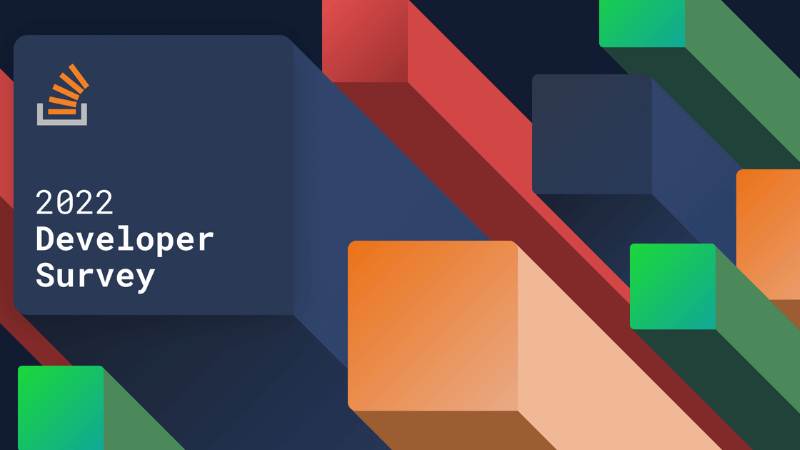2022 Stack Overflow Survey: What Are The Most Popular Languages Among Developers, And Which Pay The Most?
16th November, 2022 5 minutes
This year’s 2022 Stack Overflow Developer Survey sheds a light on the current state of the development market globally, following a strong bounce back for opportunities and salaries in 2021. With over 72,000 professionals surveyed, the survey provides valuable insight into trends in the market, such as languages most commonly used and most desired to be used among developers, highest-paid job titles, and more. We’ve gone through the full report so you don’t have to – check out the highlights below!
A note on the data: of the total 73,268 responses collected by programming website Stack Overflow, just over 73% of the participants are Developers by profession, with 8.6% currently in the process of learning to code (primarily 18-24 year olds), and 7.9% stating they sometimes code as part of their work, but they’re not primarily a Developer, with the rest largely hobbyists or former Developers. The majority of survey takers were in the 25-34 years old age bracket, followed by the 18-24 year old and 45-44 years old groups.
Full-stack, back-end, front-end, and desktop developers, account for the majority of all respondents. Few participants considered themselves a single Developer type, with most considering themselves more than one type, but especially SREs, DBAs, and security professionals, who on average reported being seven other types of Developer. Stack Overflow enquired about Cloud infrastructure engineers for the first time this year and found almost 9% classify themselves as this type of developer.
The majority of participants in the survey stated they have 5 to 9 years of experience (29.3%) with coding, followed by those with 1 to 4 years of experience (18.6%), and 10 to 14 years of experience (18.9%).
Are more people learning to code, and where?
Interestingly, Stack Overflow reports a 10% increase to 70% (from 60% in 2021) in individuals that are learning to code online, and the younger the respondent, the more likely they are to turn to online courses and certifications over offline resources. Technical documentation, Stack Overflow itself, blogs, how-to videos, and written tutorials, were voted as the most relied upon online resources for learning how to code, among other resources.
When it comes to specific online platforms for taking a course on how to code, Udemy (66.5%) came out on top, followed by Coursera (34.9%) and Codecademy (26.2%).
WHAT LANGUAGES ARE MOST POPULAR?
As expected, this year sees JavaScript fly high once again and be the most commonly used programming language (for the 10th year in a row!), according to Stack Overflow readers.
The picture changes, however, when looking at the data for those learning to code – these individuals show a strong preference for the likes of HTML/CSS (62.6%), then followed by JavaScript and Python.
Of web frameworks, Node.js (46.3%) and React.js (44.3%) are the two most commonly used web technologies used by professional Developers.
Looking at ‘most-loved’ Cloud platforms, AWS remains the number one choice among the majority of Developers (66.3%), followed by Microsoft Azure (59.4%) and Google Cloud (58.2%). Similar to Stack Overflow’s findings in 2021, a significant number of AWS Developers reported that they want to develop in Google Cloud or Microsoft Azure next year.
The continued rise of Rust
In the 2022 survey, Rust hit 7th year in a row for the ‘most-loved language’ among Developers (followed by Elixir) as well as ranking in joint first place with Python out of ‘most-wanted’ programming, scripting, and markup languages, among professionals (with TypeScript ranking second).
When it came to what technologies Developers are interested in working with based on what they are currently using, Rust again came out near the top, with over 10,000 JavaScript Developers keen to start or continue developing in the language (or Go).
Outside of programming languages, the survey also notes a rise in the number of professionals turning their hand to 3D tools like Unity 3D (23% vs 8%) and Unreal Engine (9% vs 3%) to add VR and AR skills to their skillset.
Elsewhere, the report shows Docker and Kubernetes rank first and second for the ‘most-loved’ and ‘most-wanted’ tools, with interest in using the latter not reducing (up to 37% from 30% this year).
KEY MARKET TRENDS
Hiring continues to boom
Notably, there has been a rise in moving into full-time work and other forms of employment according to the survey. Stack Overflow reports a 4% rise in the number of professional Developers overall, with the number of Developers that are “Independent contractors, freelancers, or self-employed” growing by 5% too from its 71,709 respondents to its 2022 hiring status question.
As specialist tech recruiters, we have also seen this growth reflected in the hiring market across all of the niche technology sectors we work in, as seen in our 2022 Salary & Talent Reports.
Remote work here to stay
According to the research, as many as 85% of Developers have some remote work, with smaller organisations more likely to have in-person attendance (i.e. 20% of 2-19 employee organisations). At the opposite end of the spectrum, the largest organisations with over 10k employees are the most likely to offer hybrid working.
Productivity problems
The Stack Overflow survey draws attention to some glaring issues with productivity due to struggles to find solutions to problems.
A quarter spend more than an hour each day searching for solutions to problems rather than building or similar. According to the study, “For a team of 50 developers, the amount of time spent searching for answers or solutions adds up to between 333-651 hours of time lost per week across the entire team.”
What is the top-paying language?
Whilst it’s worth noting that the majority of the Developers that responded to the Stack Overflow survey were based in the U.S. due to the sheer amount of professionals in the country, and slightly over half chose to participate in the salary part of the survey, the income reporting makes for worthwhile reading. Clojure came out on top as the highest-paid language to know among all Developers making on average $106,644 (£92,509), and we’ve picked out some of the other highlights from the reported salaries below.
Median yearly salaries of Developers (exchange rate as of 09/22)
Elixir $92,959 (£80,622)
Rust $87,047 (£75,516)
Python $71,105 (£61,609)
JavaScript $65,580 (£56,838)
Java $64,572 (£56,025)
Notably, salaries reported by Developers on average saw an increase of 23% between 2021 and 2022.
As expected, the highest overall compensation was reported by individuals in senior positions like Engineering Manager or Senior Executive, who reported average earnings over the 6-figure mark. These roles were followed by Engineers focused on site reliability or data, Cloud infrastructure professionals, security professionals, as well as those working in Blockchain. The median yearly salaries of 2,600 respondents based in the UK can be seen below (in USD).
The above table show how experience level correlates to salary across different types of role involving development. The three highest-paid roles, on average, were reported by Developers with over 11 years of experience.
Lack of diversity continues among Developers
The recurrent issue of lack of gender diversity, comes to light again with Stack Overflow’s data on the gender identity of participants.
One potentially positive sign of things to come, however, is that those who reported they were in the ‘learning to code’ stage were slightly less likely to be a man or preferred not to disclose, which indicates the diversification of the industry as it opens up to new people.
Over 2% of all respondents identified as transgender (or ‘in your own words’) and nearly 16% chose an option other than ‘Straight/Heterosexual’ when it comes to their sexual orientation, stressing the importance of creating a diverse, LGBTQ-friendly workforce.
The majority of Developers who took part in the survey said they were White (39.4%) or European (37.3%).
Responses to a question regarding neurodiversity increased and saw more developers identifying as having a concentration and/or memory disorder (10.6%), anxiety disorder (10.3%), and mood or emotional disorder (9.7%).
These responses reinforce the need to both increase the push for diversity in the tech sector, but also support the existing smaller groups in the workforce.
READ THE FULL 2022 STACK OVERFLOW REPORT.



